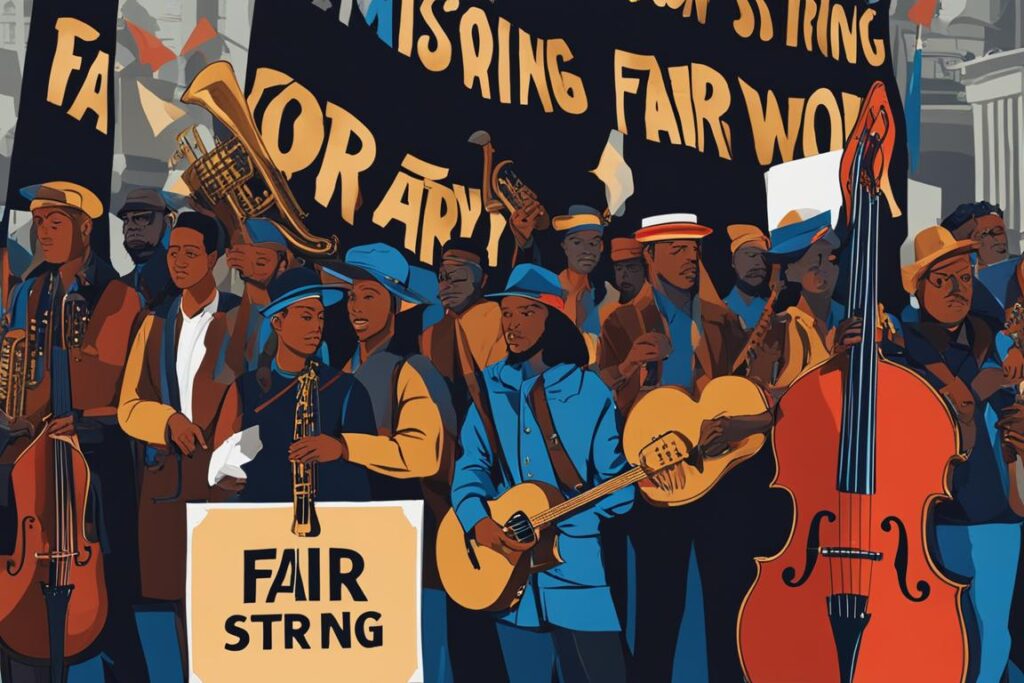Musician Salary : When considering a career in music, it’s essential to understand the average musician salary and the factors that influence it. While the exact figure can vary, the average musician salary in the United States is around $70,000 per year. However, several factors impact the actual pay that musicians receive.
The type of employment is a critical factor in determining musician income. Some musicians receive a fixed salary, while others are paid per performance. Additionally, the position within an orchestra can influence earnings. Union negotiations and collective bargaining also play a significant role in shaping musician salaries.
Key Takeaways:
- The average musician salary in the United States is approximately $70,000 per year.
- The type of employment, such as salary-based or per-performance, impacts musician income.
- The position within an orchestra can influence salary levels.
- Union negotiations and collective bargaining play a significant role in determining musician pay.
- Factors like education, industry demands, and location can affect musician salaries.
Factors Affecting Musician Salaries
When it comes to determining musician salaries, several factors come into play. Understanding the key elements that influence these earnings can shed light on the variations in pay within the music industry. This section explores some of the crucial factors that affect musician salaries.
Educational Background
Education plays a significant role in influencing musician salaries. Musicians with extensive training and formal education in music tend to earn higher wages. Advanced degrees, certifications, and specialized training can enhance a musician’s skills, making them more marketable and desirable to employers. The level of education attained can often correlate with increased earning potential.
Industry Demands
The demand for certain types of music or instruments directly impacts musician salaries. Popular genres or instruments that are in high demand tend to command higher compensation due to market forces. Musicians who specialize in these sought-after areas may have better opportunities for higher-paying gigs or positions. Adaptability to changing industry demands can be essential for musicians looking to maximize their earning potential.
Skills and Experience
A musician’s skill level and experience also contribute to their salary potential. Musicians with exceptional talent, technical proficiency, and a track record of successful performances are often able to command higher wages. Building a strong portfolio, gaining experience through live performances, and collaborating with renowned artists can all contribute to an artist’s market value and ability to negotiate higher pay.
Location
The location where a musician works can significantly impact their salary. Different regions and cities may have varying costs of living, labor markets, and local music scenes, all of which can influence compensation levels. Major metropolitan areas with thriving music industries, such as Los Angeles, Nashville, and New York, often offer more opportunities and higher pay for musicians compared to smaller towns or regions with less music industry activity.
Summary
In summary, musician salaries are influenced by education, industry demands, skills and experience, and location. Advanced education, specialization in high-demand areas, exceptional talent, and working in music hubs can all contribute to higher earnings. Understanding these factors can help musicians navigate career decisions and maximize their income potential.
Types of Employment for Musicians
Musicians have diverse employment options, with variations in pay structure and benefits. Let’s explore the different types of employment available to musicians and their implications on salary.
Salary-based Employment
Some musicians are employed on a salary basis, where they receive a fixed weekly or annual paycheck, irrespective of the number of performances. This type of employment provides financial stability and a consistent income stream. Salary-based musicians may also be eligible for benefits such as health insurance, retirement plans, and paid time off.
Per-performance Employment
Alternatively, some musicians are compensated on a per-performance basis. These musicians are paid for each individual service they provide, such as rehearsals or performances. While per-performance employment offers the potential for higher earnings based on the number of gigs, it often lacks the financial security and stability provided by salary-based employment. Musicians in per-performance roles typically need to actively seek opportunities to increase their earnings.
It’s important for musicians to consider their financial goals and personal circumstances when choosing between salary-based and per-performance employment. Both options have their pros and cons, and the right choice depends on individual preferences and priorities.
| Employment Type | Salary Structure | Benefits |
|---|---|---|
| Salary-based | Fixed weekly or annual paycheck | Health insurance, retirement plans, paid time off |
| Per-performance | Compensated for each individual service | No fixed benefits |
Case Study: Salary vs. Per-performance
In a study conducted by the American Musician’s Federation, it was revealed that musicians employed on a salary basis earn a median annual income of $65,000, while per-performance musicians have a median income of $45,000 per year. This highlights the potential financial disparity between the two types of employment.
“I’ve always preferred the stability of a salary-based position. It allows me to focus on my music without worrying about where my next paycheck is coming from.” – Emma Davis, Orchestra Violinist
Despite the potential for higher earnings in per-performance roles, the stability and additional benefits provided by a salary-based position can be attractive to many musicians.

Pay Structure for Orchestra Musicians
Orchestra musicians have a unique pay structure that differs from other types of employment. Instead of receiving a fixed salary, they are often paid per service, which means they receive payment for each rehearsal or performance they participate in.
This pay structure allows orchestras to compensate musicians based on the actual services they provide, rather than a predetermined salary. It also ensures that musicians are rewarded for their time and effort spent preparing for and performing in each event.
It’s important to note that the pay rate for rehearsals and performances can vary among different orchestras. Some orchestras may pay the same rate for both rehearsals and performances, while others may have different rates for each. The specific details of the pay structure are typically outlined in the musician’s contract or collective bargaining agreement.
The pay for orchestra musicians can also vary based on their position within the orchestra. Principal players, who hold leadership roles, often receive higher pay compared to section players. Additionally, musicians who hold full-time positions with an orchestra generally earn a more stable income compared to those who are freelancers or substitute players.
Example Pay Structure for Orchestra Musicians
To illustrate the pay structure for orchestra musicians, here is an example breakdown:
| Position | Rehearsal Rate (per service) | Performance Rate (per service) |
|---|---|---|
| Principal Player | $100 | $200 |
| Section Player | $75 | $150 |
| Freelancer | $50 | $100 |
This example demonstrates how the pay structure can vary based on the musician’s position and whether they are participating in a rehearsal or a performance. It also highlights the potential difference in earnings between full-time orchestra members and freelancers.
Overall, the pay structure for orchestra musicians reflects the unique nature of their work and the value they bring to each service they perform. It offers a fair compensation system that considers the time, skill, and dedication required to deliver exceptional musical performances.
Next, we’ll explore the role of collective bargaining and union influence on musician pay, and how these factors contribute to establishing fair wages and working conditions in the industry.
Collective Bargaining and Union Influence on Musician Pay
In the world of music, collective bargaining and union influence have a significant impact on musician salaries. The International Conference of Symphony and Opera Musicians (ICSOM) leads the way in representing thousands of musicians in orchestra negotiations throughout the United States. These negotiations play a crucial role in establishing fair wages, working conditions, and ensuring the overall well-being of musicians in the industry.
Through collective bargaining, unions help musicians secure minimum payment guarantees, benefits, and essential protections. Union agreements ensure that musicians are fairly compensated for their artistic contributions and dedication. By advocating for musicians’ rights, unions play a pivotal role in shaping the economic landscape of the music industry.
“Union agreements often ensure minimum payment guarantees, benefits, and protections for musicians. These negotiations help establish fair wages and working conditions for musicians in the industry.”
The International Conference of Symphony and Opera Musicians (ICSOM) operates as a united front, providing a unified voice for musicians during negotiations. By working collaboratively with management and employers, ICSOM helps establish equitable pay structures that reflect the value and importance of musicians in symphony and opera organizations.
These union-driven negotiations not only focus on musician salaries but also encompass other critical aspects, such as health benefits, retirement plans, and job security. By coming together as a collective, musicians have greater leverage in achieving favorable outcomes and ensuring their long-term financial stability.
Union Influence on Musician Pay
The influence of unions on musician pay extends beyond individual negotiations. Union-driven agreements set a standard that raises the bar for all musicians, creating a ripple effect throughout the industry. As union-negotiated contracts establish fair compensation for musicians in one orchestra or organization, it sets a precedent that inspires other musicians to strive for similar standards in their own work environments.
This collective approach to negotiating salaries and working conditions helps address income disparities and fosters a more balanced and sustainable industry. By incorporating collective bargaining and union influence, the music industry can ensure that talented musicians receive just compensation for their contributions and maintain a thriving community of artists.
The Impact of Collective Bargaining
Collective bargaining not only benefits musicians’ economic well-being but also contributes to their overall job satisfaction and security. By negotiating and enforcing comprehensive collective bargaining agreements, musicians gain peace of mind, knowing that they are protected and valued in their profession.
The International Conference of Symphony and Opera Musicians (ICSOM) plays a critical role in guiding negotiations and advocating for the rights of musicians. Through their efforts, musicians can focus on their craft and artistry, knowing that their interests are being represented and protected by a larger organization.
The International Conference of Symphony and Opera Musicians (ICSOM)
The International Conference of Symphony and Opera Musicians (ICSOM) is an influential organization that holds annual conferences, where representatives discuss critical industry matters, negotiate agreements, and address the concerns of symphony and opera musicians.
ICSOM serves as a strong voice for musicians, empowering them to address challenges collectively and ensure the sustainability of their careers. Through their dedication to collective bargaining and union influence, ICSOM brings about positive change that benefits musicians nationwide.
| Key Points |
|---|
| Collective bargaining and union negotiations significantly impact musician salaries |
| The International Conference of Symphony and Opera Musicians (ICSOM) represents thousands of musicians in orchestra negotiations across the United States |
| Union agreements ensure minimum payment guarantees, benefits, and protections for musicians |
| ICSOM’s role in collective bargaining empowers musicians and enables equitable compensation structures |
| Collective bargaining raises the bar for all musicians and fosters a more balanced industry |
| Through collective bargaining, musicians gain job security and enhanced job satisfaction |
| The International Conference of Symphony and Opera Musicians (ICSOM) advocates for the rights of musicians |

The Impact of Streaming on Musician Income
The rise of streaming platforms like Spotify and Apple Music has revolutionized the music industry and significantly influenced musician income. In particular, independent musicians have witnessed a substantial growth in streaming income as these platforms provide a level playing field for artists to reach a global audience.
Streaming services have contributed to increased royalty revenues, further bolstering the overall income of musicians. With millions of users streaming music every day, artists have the opportunity to earn passive income by monetizing their songs on these platforms.
However, it’s important to note that the exact amount earned per stream can vary depending on several factors, including the listener’s location and the record label agreements in place. Different territories and licensing agreements may have varied royalty rates, impacting the streaming income of musicians.
With the traditional model of album sales giving way to the dominance of streaming, musicians need to adapt their revenue strategies accordingly. While streaming income may not be as lucrative as selling physical copies in the past, it has become a vital component of an artist’s overall earnings.
It’s worth mentioning that streaming income alone may not be sufficient for musicians to rely on exclusively. Diversifying income sources has become increasingly important for sustained financial stability. This can include live performances, merchandise sales, licensing deals, and other creative avenues that complement streaming revenue.
In summary, streaming platforms have opened up new avenues for musicians to earn income, especially for independent artists. While the exact earnings per stream may vary, it presents an opportunity for artists to reach a wider audience and generate revenue in the digital age.

The Growth of Streaming Income for Independent Musicians
“Streaming has allowed us to connect directly with our fans in a way that was unimaginable before. We no longer have to rely solely on record labels for exposure and income,” says Emma Johnson, an independent singer-songwriter who has seen significant success through streaming platforms.
The rise of streaming has empowered independent musicians to take control of their careers, as they no longer need major record labels to distribute their music. With a simple upload, artists can share their work with millions of listeners worldwide, removing the barriers that previously existed in the industry.
“Streaming has unlocked endless opportunities for independent musicians like me. It has given us the chance to earn a living solely through our music, without having to compromise our artistic vision.”
Moreover, the democratisation of streaming platforms means that artists receive royalties based on their music’s popularity, rather than being subjected to the gatekeeping of traditional music industry gatekeepers.
In the past, independent musicians faced significant barriers to entry, often struggling to secure record deals or receive fair compensation for their work. Streaming has leveled the playing field, allowing artists to be heard and compensated for their creativity and talent.
“Streaming income has given me the financial freedom to focus on my music full-time. It’s a game-changer for independent artists who want to make a living doing what they love,” adds Johnson.
The Importance of Royalty Revenues in the Streaming Era
Royalty revenues have become a critical income stream for musicians in the streaming era. These revenues are generated when songs are streamed by users, and artists receive a percentage of the revenue generated by the streaming platforms.
“Royalty revenues have become an integral part of my income as a musician. With streaming, my music has the potential to reach a global audience, and I’m compensated for every stream,” says David Miller, a singer-songwriter who has amassed millions of streams on various platforms.
While some critics argue that the per-stream payout may be relatively low, the sheer volume of streams and the global accessibility of streaming platforms can make up for this. Musicians have the opportunity to earn an income from a vast audience base that was virtually unthinkable in the past.
However, it’s essential for musicians to understand the nuances of the royalty system and the impact it can have on their income. Factors such as the user’s location, the type of subscription they have, and the record label agreements in place can affect the compensation musicians receive per stream.
The Future of Musician Income in the Streaming Age
As streaming continues to dominate the music industry, musician income will depend on how artists adapt to this evolving landscape. Musicians should consider developing a comprehensive strategy that combines streaming revenue with other income sources, such as live performances, merchandise sales, and fan engagement.
While the transition to streaming has posed challenges for certain sectors of the industry, it has also opened up opportunities for artists to have direct access to their fanbase and build a sustainable career.
By embracing the potential of streaming platforms and understanding how to leverage them effectively, musicians can navigate the streaming age and secure their financial future. The ability to reach a wide audience and generate income through streaming offers unprecedented possibilities for artists to pursue their passion and succeed in the modern music industry.
Additional Income Sources for Musicians
Musicians often rely on additional income sources to supplement their earnings. While the musician salary itself may not always be enough to cover all expenses, these additional income streams can help musicians diversify their revenue and increase their overall earnings.
Live Gigs
One of the main ways musicians supplement their income is by performing live gigs. Whether it’s playing at local bars, clubs, weddings, or corporate events, gigs provide an opportunity for musicians to showcase their talents and earn a fee for their performances. Live gigs not only generate income but also allow musicians to expand their fan base and gain exposure to new audiences.
Merchandise Sales
Merchandise sales can be a lucrative source of income for musicians. From t-shirts and hoodies to CDs, vinyl records, and even signature items, musicians can create merchandise that resonates with their fans and generates revenue. Selling merchandise at concerts, through online stores, and on social media platforms allows musicians to connect with their audience on a deeper level while also boosting their income.
Teaching Music Lessons
Many musicians have the expertise and experience to teach music lessons. Teaching lessons can be a rewarding way for musicians to share their knowledge and skills while earning an additional income. Musicians can offer private lessons, teach at music schools, or provide virtual lessons through online platforms, reaching students of all ages and skill levels.
Licensing Music for Commercial Use
Licensing music for commercial use can provide musicians with a passive income stream. By granting permission for their songs to be used in advertisements, films, TV shows, and other media, musicians can earn royalties and synchronization fees. This allows them to monetize their music beyond traditional album sales and performances.
Part-Time Jobs
In addition to these direct music-related income sources, many musicians also have part-time jobs outside of their music careers. These jobs provide a stable income to cover living expenses and help support their music endeavors. Whether it’s teaching at a music store, working at a music venue, or pursuing other interests and skills, part-time jobs offer financial stability while musicians pursue their passion.
| Additional Income Source | Description |
|---|---|
| Live Gigs | Performing at various venues and events to earn fees and gain exposure. |
| Merchandise Sales | Selling branded merchandise such as t-shirts, CDs, and vinyl records. |
| Teaching Music Lessons | Offering private or group music lessons to students of all ages and skill levels. |
| Licensing Music for Commercial Use | Granting permission for songs to be used in advertisements, films, TV shows, etc. |
| Part-Time Jobs | Seeking employment outside of the music industry to supplement income. |

>Case Study: Income Breakdown for an Indie Rock Composer-Performer
In order to gain a better understanding of musician salaries and income breakdowns, let’s take a closer look at a case study featuring an indie rock composer-performer. This specific case study will provide insights into the various sources of income as well as the expenses incurred by a musician who writes, records, and performs their own music.
The breakdown of income for our indie rock composer-performer includes:
- Live Performances: A significant portion of the musician’s income comes from live performances. These can include gigs at local venues, festivals, and even private events. The income generated from live performances greatly depends on factors such as ticket sales, venue capacity, and popularity.
- Salaried Playing: Our indie rock composer-performer also receives a salary from being part of a band or musical ensemble. This regular income provides stability and helps cover basic expenses.
- Performing Rights Royalties: As a composer-performer, our musician earns royalties from the performance and broadcast of their music. These royalties are collected through performing rights organizations and are based on factors such as airplay, digital streaming, and licensing.
- Merchandise: Selling merchandise, such as t-shirts, CDs, and other merchandise featuring the musician’s branding, can be a significant source of income. This not only adds to the revenue stream but also serves as a form of promotion and fan engagement.
- Online Streaming: With the advent of digital platforms, our indie rock composer-performer earns income from online streaming services such as Spotify, Apple Music, and YouTube. While the earnings per stream may vary, the cumulative royalties from widespread streaming contribute to the overall income.
- Other Miscellaneous Income: Additional income may come from other sources such as music licensing for commercials, film, and TV placements, as well as collaborations with other artists.
It’s important to note that while these income sources can contribute to a musician’s earnings, expenses must also be taken into account. Some common expenses incurred by our indie rock composer-performer include:
- Travel: As musicians often need to travel for performances and tours, expenses related to transportation, accommodation, and meals are necessary.
- Equipment: Investment in musical instruments, amplifiers, microphones, and other equipment is crucial for maintaining the quality of performances and recordings.
- Publicity: Effective promotion and marketing are essential for gaining visibility and attracting a larger audience. This may involve expenses related to social media advertising, website maintenance, and hiring publicists or PR agencies.
- Miscellaneous Expenses: Other miscellaneous expenses may include studio rental fees, session musicians’ fees, music production costs, and insurance.
By considering both the income breakdown and the associated expenses, our case study provides a comprehensive understanding of the financial aspects of being an indie rock composer-performer. It highlights the diversification of income sources and the careful management of expenses required to sustain a music career.
The Role of Collective Bargaining in Job Security
Collective bargaining plays a crucial role not only in influencing musician salaries but also in ensuring job security within the industry. Musicians who are part of the American Federation of Music (AFM) benefit from the added protection provided by collective bargaining agreements. These agreements are the result of negotiations between the AFM and employers, establishing fair pay rates and working conditions for musicians.
Through collective bargaining, musicians are able to secure job security by advocating for their rights and interests as a united front. These agreements often include clauses that ensure musicians receive equitable compensation for their work, including per-service rates and benefits. By unionizing and participating in collective bargaining, musicians can protect their livelihoods and contribute to a more stable and sustainable industry.
“Collective bargaining provides musicians with a voice and the ability to negotiate fair wages and working conditions. It allows us to come together and protect our rights as professionals in the music industry.”
Furthermore, collective bargaining agreements establish standardized practices that promote transparency and consistency across the industry. Musicians can rely on these agreements to ensure that they are treated fairly and consistently, regardless of their position or the size of the ensemble they perform with.
Benefits of Collective Bargaining for Musicians:
- Ensures fair compensation: Collective bargaining helps set minimum pay rates and guarantees for musicians, ensuring they receive fair compensation for their work.
- Protects against exploitative practices: Unions and collective bargaining agreements guard against exploitative practices, such as unreasonable work hours or hazardous conditions.
- Provides access to benefits: Through collective bargaining, musicians can secure benefits such as healthcare coverage, retirement plans, and paid time off.
- Promotes professional development: Union contracts often include provisions for ongoing training and professional development opportunities, helping musicians enhance their skills and stay relevant in the industry.

By actively participating in collective bargaining through organizations like the American Federation of Music (AFM), musicians can influence and shape their own professional landscape. Through this process, they are not only securing fair pay for their work but also shaping the future of the music industry.
The Impact of COVID-19 on Musician Pay
The COVID-19 pandemic has had a profound impact on the music industry, including the salaries of musicians. With live performances canceled or limited due to social distancing measures, many musicians have experienced a significant decrease in income. The New York Philharmonic Orchestra, a renowned institution, has had to implement pay cuts to sustain its operations during this challenging time.
To further highlight the impact, let’s take a closer look at the specific pay cuts implemented by the New York Philharmonic Orchestra:
| Position | Pre-COVID Salary | COVID Salary | Percentage Change |
|---|---|---|---|
| Concertmaster | $250,000 | $200,000 | 20% |
| Principal Violin | $175,000 | $140,000 | 20% |
| Principal Cello | $150,000 | $120,000 | 20% |
| Principal Bass | $130,000 | $100,000 | 23% |
The table above showcases the percentage decrease in salaries across different positions within the orchestra. These reductions are a reflection of the financial strain that orchestras have faced due to the pandemic. The New York Philharmonic Orchestra serves as an example of how even prestigious institutions have had to make difficult decisions to navigate these challenging times.
As the industry continues to grapple with the repercussions of the pandemic, it is uncertain when musician pay will fully recover. The path to recovery may take years, with musicians and orchestras alike facing an uphill battle to return to pre-pandemic salary levels.

Opportunities and Challenges for Musicians in the Modern Era
The modern era has brought forth both exciting opportunities and formidable challenges for musicians. With the rise of streaming platforms and digital distribution, independent musicians now have greater access to a vast and global audience, allowing them to showcase their talent and potentially generate a steady income. Streaming has revolutionized the way music is consumed, creating new avenues for artists to share their creativity with the world.
However, with these opportunities come significant challenges. The music industry has become fiercely competitive, as countless artists vie for the attention of listeners. Breaking through the noise and standing out from the crowd is no easy feat. Independent musicians must be strategic and innovative in their approach, employing marketing tactics and engaging with their fanbase to build a loyal following.
In addition to competition, musicians must also navigate the complexities of the streaming landscape. While streaming provides exposure and potential income, the revenue generated from streaming platforms is often modest, especially for independent artists. The payment structure can be complex and varies depending on factors such as listener location and record label agreements. Musicians need to explore other monetization avenues, such as merchandise sales, live performances, and licensing their music for television, movies, and advertisements.
Yet, despite the challenges, musicians have more control over their careers than ever before. They can independently release their music, connect directly with their audience through social media, and establish their unique brand. Artists can experiment with different genres, collaborate with fellow musicians across the globe, and truly showcase their artistic vision without the limitations of major label influence.
The modern era demands resilience, adaptability, and resourcefulness from musicians. While the path may be challenging, it also presents boundless opportunities for those who are willing to embrace the digital age and learn how to navigate its intricacies.
Conclusion
While pursuing a music career, the desire for high salaries is not the sole driving factor for musicians. Many individuals choose a career in music because of their passion for the art form and their deep-seated desire to share their unique voice with the world. They understand that pursuing a music career is a labor of love, and the financial aspect, although important, does not overshadow their dedication to their craft.
In today’s digital age, aspiring musicians have more opportunities than ever to pursue their dreams and find their audience. The advent of streaming platforms, social media, and online music distribution has created a viable avenue for independent artists to showcase their talent and connect with listeners worldwide. With perseverance and creativity, musicians can carve their own paths and build a sustainable music career.
However, pursuing a music career requires diligence and patience. It takes time to establish oneself in the industry and gain recognition. Musicians must be willing to put in the hours of practice, hone their skills, and continuously learn and adapt to the ever-changing music landscape. While there may be challenges along the way, the joy and fulfillment that come from pursuing your passion make it all worthwhile.
So, if you have a burning passion for music and the determination to pursue your dream, now is a viable time to embark on a music career. Embrace the opportunities that the digital era presents, cultivate your unique artistic voice, and share your music with the world. Remember, true success as a musician goes beyond financial gain; it lies in making a meaningful impact through your art.
Also Read : Online Music Degree: Flexible Learning For Musicians
FAQ
Q: What is the average salary for a professional musician?
A: The average salary for a professional musician can vary depending on factors such as experience, location, and type of engagement. According to available data, the median annual wage for musicians and singers was $30.39 per hour in May 2019.
Q: How does the education level of a musician relate to their salary?
A: Generally, the level of education can impact a musician’s earning potential. Musicians with a more advanced education or specialized training may command higher fees for their performances or be eligible for more lucrative opportunities.
Q: What are some factors that can affect the total pay for a musician?
A: Several factors can influence a musician’s total pay, including their level of experience, the type of engagements they secure, the size of their audience, any additional pay such as bonuses or royalties, and the demand for their particular skills.
Q: How can musicians estimate their compensation for a specific performance or gig?
A: Musicians can estimate their compensation for a performance or gig by considering various factors such as the duration of the event, the location, the type of venue, and their own professional standards and fee structure.
Q: What are the major sources of earnings for professional musicians?
A: Professional musicians can earn income from a variety of sources including performance fees, royalty payments, commissions, and tips. They may also receive additional pay for responsibilities such as teaching, conducting, or leading musical groups.
Q: How does work experience impact a musician’s earning potential?
A: Generally, musicians with more work experience may have developed a larger network, a stronger reputation, and the ability to command higher fees for their services. However, work experience is just one factor among many that determine a musician’s earning potential.
Q: Where can I find reliable information about musician salary averages?
A: Reliable information about musician salary averages can be obtained from government sources, professional organizations, music industry publications, and online job boards that specialize in musical positions.
Q: How can musicians compare their compensation with others in the industry?
A: Musicians can compare their compensation with others in the industry by seeking out industry reports, salary surveys, and benchmarking data specific to their genre, region, and level of experience.
Q: Are there additional resources available for musicians seeking salary information?
A: Yes, there are additional resources available for musicians seeking salary information. These may include industry websites, career counselors, music unions, and professional development workshops that cover topics related to compensation and career growth.
Q: What are some factors musicians should consider to become more profitable in their careers?
A: Musicians looking to become more profitable in their careers should consider factors such as diversifying their income streams, improving their competency in their craft, building a strong online presence, and seeking out opportunities for profit sharing or musical collaborations.












